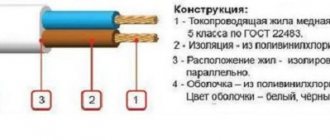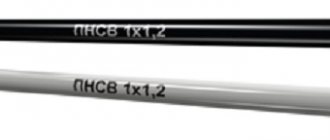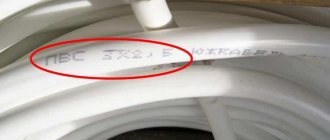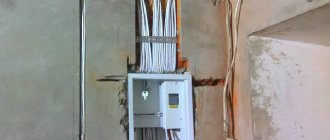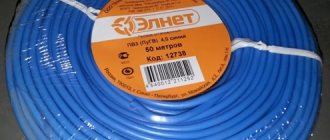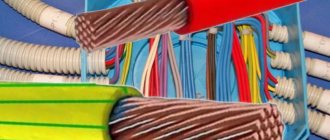Automatic reclosure wires
Automatic reclosure electrical wires have been used in industry for quite a long time. And until recently they were widely used in construction. But due to changes made to the PUE in 2001, the use of aluminum wires in the construction of residential buildings became prohibited. This has significantly reduced the scope of use of recloser wire and other wires made of aluminum.
Description and design of the automatic reclosure wire
APV - (aluminum wire APV) with one aluminum core, with PVC insulation.
Explanation of the designation:
“A” at the beginning – aluminum core; "P" - wire; “B” - PVC insulation (vinyl).
Example of designation: APV 2.5 - APV wire with a conductor cross-section of 2.5 mm2
Since the wires are intended mainly for industrial use and are designed for a long service life, GOST sets stringent requirements for finished products in terms of structural, electrical and mechanical parameters. The values of individual parameters are also regulated for the period of operation and storage.
The range of produced sections is from 2 to 120 mm2.
Cores up to 16 mm2 inclusive are made only monolithic, from 25 mm2 and above must be twisted from individual wires (number of wires: at least 7 for sections 25 and 35 mm2; at least 19 for sections 50, 70 and 95 mm2; at least 37 for section 120 mm2).
The insulation must fit tightly to the core and be removed without damaging the core. The nominal and minimum values of the radial insulation thickness and the maximum outer diameter for wires of the most commonly used sections up to 50 mm2 are given in the table.
| Nominal cross-section, mm2 | Nominal insulation thickness, mm | Minimum insulation thickness, mm | Maximum outer diameter, mm |
| 2,5 | 0,8 | 0,62 | 3,9 |
| 4 | 0,8 | 0,62 | 4,4 |
| 6 | 0,8 | 0,62 | 4,9 |
| 10 | 1,0 | 0,8 | 6,4 |
| 16 | 1,0 | 0,8 | 8,0 |
| 25 | 1,2 | 0,98 | 9,8 |
| 35 | 1,2 | 0,98 | 11,0 |
| 50 | 1,4 | 1,16 | 13,0 |
It is allowed to repeat the configuration of the current-carrying core on the insulation surface within permissible deviations.
Wires must be made in different colors. The coloring must be solid or done by applying two longitudinal stripes to the insulation of a natural color, located diametrically. For single-core wires used for grounding purposes, the insulation should be a solid yellow-green color.
The color of solid insulation or longitudinal strips must be specified in the order (the letters indicated in the table are added to the wire designation when ordering, for example: APV Zh 2.5.
| Color | Designation |
| White, natural or gray | B |
| Yellow or orange or purple | AND |
| Red or pink | TO |
| Blue or cyan | WITH |
| Green | Z |
| Brown | Kch |
| Black | H |
| Yellow-green | Z-Z |
If there is no indication of a specific color in the order, the manufacturer supplies wires at its discretion, while it is allowed to supply wires with insulation of transitional and mixed colors (designation “BC”) in a volume of no more than 10% of the batch.
Application area
The characteristics of the autorecloser wire allow it to be laid in electrical cabinets and switchboards. This conductor is excellent for assembling distribution boards. Often found in control panels and push-button stations. In general, the application area is suitable for many types of fixed connections.
Also, the AR wire can be used, for example, for permanent connection of auxiliary and working equipment, such as a cable for heating concrete. Sometimes it is used for a one-time connection as an extension cord to a power source (welding machine or mobile transformer substations).
If there is a need to carry out external wiring, you need to use trays, boxes, cable ducts, etc. to lay the automatic reclosure wire. This is necessary to protect the insulation from mechanical damage, such as abrasion, and also to protect it from ultraviolet radiation.
For the same reason, APV is not suitable for overhead lines, but if you need wires for entry into the house, for example, when connecting to a SIP supply wire on the street, then it is possible to lay the APV in a PVC corrugated or metal hose.
Analogues:
- Instead of automatic reclosing, you can use copper PV-1; it is closer to it in flexibility than the others (PV-3, PV-4).
- AVVG is a cable with double PVC insulation, available with different numbers of cores, the most popular are 3 and 4 pieces. If individual aluminum conductors are required, you can simply remove the outer sheath from the cable.
- APPV is a flat wire with monolithic conductors, there can be 2 or three conductors, enclosed in PVC insulation and laid in one plane. There is one layer of insulation.
Technical characteristics of the automatic reclosure wire
The electrical resistance of current-carrying conductors at direct current for wires with a cross-section of up to 50 mm2 upon acceptance and delivery must be no more than that indicated in the table.
| Nominal conductor cross-section, mm2 | 2,5 | 4 | 6 | 10 | 16 | 25 | 35 | 50 |
| Copper conductor resistance, Ohm/km | 12,1 | 7,41 | 5,11 | 3,08 | 1,91 | 1,20 | 0,868 | 0,641 |
For the period of operation and storage, it is allowed to increase the specified resistance values of the cores by 20%.
The electrical insulation resistance per 1 km of length at a temperature of 20°C must be at least 1 MOhm upon acceptance and delivery and at least 0.01 MOhm for the period of operation and storage.
Upon acceptance and delivery, finished wires must withstand, when immersed in water without preliminary exposure to it, testing with an alternating voltage of 2000 V at a frequency of 50 Hz for 5 minutes, applied between the conductor and water (for the period of operation and storage - 1000 V under the same conditions).
The wires must withstand winding at a temperature of minus 15°C onto a cylinder (drum) with a diameter equal to 5 outer diameters of the wire (in a special installation directly in the refrigerating chamber).
Interaction of AIIB devices and relay protection.
For networks consisting of series-connected sections with their own circuit breakers and relay protection, the “Rules” provide for the following types of interaction between automatic reclosure and relay protection: acceleration of protection after automatic reclosing; acceleration of protection before automatic reclosure; use of automatic reclosing of different frequencies. These measures are intended to speed up the disconnection of the short circuit. and increasing the efficiency of automatic reclosure, as well as to ensure selective shutdowns of damaged areas in cases where relay protection in neighboring areas cannot have full selectivity stages. Acceleration of protection after automatic reclosure is carried out by using a pulse contact of a time relay in the overcurrent protection circuit or by briefly putting into operation an additional set of overcurrent protection. For example, in a 10 kV network consisting of three sections (Fig. 25, a), protections 1, 2, 3, due to close time delays, are triggered simultaneously during a short circuit. at point K, and for protections 1 and 2 these actions are non-selective.
Rice. 25. Schemes of 10 kV networks for which it is advisable to accelerate protection after automatic reclosure (a) and before automatic reclosure (b) The automatic reclosure device on circuit breaker 1 has the opportunity to operate first, since there is voltage on the side of the 10 kV buses of substation A. When the circuit breaker is turned on by the automatic reclosure device for a short period of time (about 1 s), the action of protection 1 is accelerated to 0.2 s (instead of 0.8 s). If k.z. occurred in section 1-2, then breaker 1 would be quickly tripped by this accelerated protection. But with short circuit at point K behind switches 2 and 3 that have switched off, protection 1 does not work and after 1 s its response time again becomes 0.8 s. After successful switching on of switch 1, voltage appears on the automatic reclosure circuit of switch 2. After a few seconds, the automatic reclosure device is triggered, switch 2 is turned on and at the same time protection 2 is accelerated to 0.2 s. But protection 2, like protection 1, does not work due to the fact that the short circuit. occurred at point K. If K.Z. was in section 2-3, protection 2 along the acceleration circuit would have worked faster than protection 1, and the selectivity level would have been sufficient: 0.6 s. After successful switching on of switch 2, voltage appears on the automatic reclosure circuit of switch 3. After a few seconds, the automatic reclosure device is triggered, switch 3 is turned on, at the same time the acceleration circuit of protection 3 is introduced to 0.2 s and switch 3 is turned off, much earlier than protection 2 could have acted. , in which by this time the accelerated stage of 0.2 s has already been taken out of action and a constant time setting of 0.7 s has been introduced (Fig. 25, a). Acceleration of protection on a direct operating current is simple and is provided for in standard design diagrams. To speed up protection on alternating operating current when using relays RT-80, RTV, RTM, additional equipment is required, so such circuits are rarely used. Acceleration of protection before automatic reclosure. This event allows you to speed up the disconnection of the short circuit. in a network consisting of several sections connected in series or to facilitate the operation of several switches due to one, more powerful and reliable. On switch / (Fig. 25.6), accelerated protection with a time delay of 0.2 s is permanently introduced. With short circuit at any point in the network, for example at point K, this protection turns off circuit breaker 1 before protections 2 and 3 are triggered. When the automatic reclosure device is triggered to turn on circuit breaker 1, this accelerated protection is taken out of action for the time required for selective shutdown of the closest circuit breaker. .z. switch 3. The circuit using constant operating current is very simple. Use of automatic reclosing of different frequencies. If the selectivity levels are insufficient (Fig. 25, a), automatic reclosure devices with different multiplicity of action can be used to correct non-selective shutdowns. For example, for the network diagram in Fig. 25, I could do the following: on switch 3 - single automatic reclosure, on switch 2 - double, on switch 1 - threefold, although automatic reclosure devices with a multiplicity of more than two are not produced by industry. Correction of non-selective actions using automatic reclosure of different multiplicities is used quite often both on adjacent sections and lines, and on lines with transformers on branches. In the latter case, automatic reclosure corrects the non-selective action of protection of a 10 kV line during a short circuit. in a transformer, when the melting time of 10 kV fuse inserts is commensurate with the response time of the line protection.
- Back
- Forward
Requirements for marking the automatic reclosure wire
Wires must have the manufacturer's designation and the wire identification, which must be made in the form of a continuous marking on the insulation surface. The marking may be printed, embossed or stamped onto the surface of the wire. The distance from the end of the marking to the beginning of the next one should not exceed 500 mm. It is allowed to mark wires with a cross-section of up to 6 mm2 in the form of a distinctive thread or colored stripes or solid marks.
The label attached to the coil or drum, or on the cheek of the drum, must indicate:
— trademark of the manufacturer; — symbol of the wire (full, indicating the number of cores and cross-section); — length in meters; — gross weight (for drums) in kilograms — date of manufacture (year, month); — GOST designation.
The label must bear a technical control stamp and a certification mark.
For wires supplied on a drum, the label attached to the coil or drum, or on the cheek of the drum, must indicate the number of sections and their length through a plus sign from the top to the bottom layers in meters.
Electrical wiring in the floor using PPV
When laying copper "noodles" in a wooden floor, it should be placed in a corrugated or plastic pipe, not occupying more than 40% of the internal space. It is forbidden to lay the wiring on top of the cross beams: it must be placed either in drilled holes or in prepared cuts.
PPV wires are placed in corrugation and passed through cutouts in the beams
If a concrete screed is installed above the laid wire, it must also be equipped with an external protective casing. Upon completion of the switching, it is necessary to check the functionality of the electrical wiring under load.
Weight and size parameters of the automatic reclosure wire
Approximate weights of the most common wire cross-sections for packaging and transportation purposes are given in the table. The given values may differ for wires of different batches and manufacturers by 10% less or more.
| Section | Weight value for packaging and transportation purposes, kg/km |
| 2,5 | 15,5 |
| 4 | 21 |
| 6 | 29 |
| 10 | 47 |
| 16 | 66 |
| 25 | 114 |
| 35 | 146 |
| 50 | 202 |
The best manufacturers
Among manufacturers of automatic reclosure wires, all representatives are in demand. But in terms of prevalence we can distinguish:
- LLC "Rybinskkabel", Rybinsk.
- JSC Samara Cable Company, Samara.
- LLC "Siberian Cable Plant", Tomsk.
It is these factories that produce more or less high-quality cable products at affordable prices.
Finally, we recommend watching a video on the topic of the article:
So we looked at the characteristics, scope and purpose of the automatic reclosure wire. We hope the information provided was useful to you!
Also read:
- Brands of aluminum wires and cables
- Characteristics of cable AVBbShv
- What kind of corrugation is there for electrical wiring?
Automatic reclosure wire load currents
Permissible load currents for wires are not regulated in GOST. In accordance with the PUE, for any installation method it is recommended that for single wires not exceed the load currents indicated in the table.
| Nominal core cross-section, mm2 | Permissible load current, A |
| 2,5 | 24 |
| 4 | 32 |
| 6 | 39 |
| 10 | 60 |
| 16 | 75 |
| 25 | 105 |
| 35 | 130 |
| 50 | 165 |
Classification
Depending on the number of phases involved for re-closing, all automatic reclosures are divided into:
- Single-phase - designed for automatic input of only one phase in which a short circuit occurred, as a rule, used for lines of 500 kV and above;
- Three-phase - characterized by the action of a switch on the drive, which immediately re-energizes all three phases;
- Combined - automatically turn on electrical devices by logical selection of one or all three, depending on the type of circuit.
In turn, three-phase automatic reclosures are divided into the following classes:
- With one-way supply - when the line is powered from only one source, accordingly, the operating current starts the reclosing circuit for only one high-voltage circuit breaker.
- With two-way power supply - when a section of the network receives power from two sources at once and the automatic reclosure system is forced to re-enable two switching devices at once.
Also, double-sided automatic reclosure is divided into:
- Non-synchronous reclosing, when the system performs simultaneous input of switches from both sides. In this case, the synchronization of switching on and processes in the line is not maintained.
- While waiting for synchronism, it supplies power first from one side and then from the other.
- With synchronism capture - selects the turn-on time in accordance with the distance of the fault point to prevent the occurrence of asymmetrical modes, electric shocks and other effects.
- High-speed automatic reclosing – allows for re-closing in the shortest possible period of time.
In addition to the above classification methods, autoreclosers can differ in the method of activation - from mechanical action or through an electrical signal. There is also a division according to the number of switching stages - one or several, depending on how many times the autorecloser tries to turn on the power again. The operating principle of restarting can be adjusted both from the presence of voltage in the line and from its absence.
Available methods for quality control of automatic reclosure wire
Control methods are presented that, while not strictly complying with GOST, allow preliminary conclusions to be drawn about the quality of the wire if the measured values differ significantly from the regulated ones. The final conclusion about the compliance of the wire with GOST can be made only after testing the wire in a specialized laboratory using strict methods and in the volumes specified in GOST.
Visual inspection The following can be checked: markings, number of wires in the core, color and integrity of the insulation.
Measuring structural dimensions The insulation thickness and outer diameter can be checked using suitable measuring tools. Measuring the wire diameter dpr and calculating the cross-section of the core using the formula 0.785dpr2N (where N is the number of wires in the core) is not a strict method for controlling the cross-section of the cores, because confirmation of cross-section compliance is electrical resistance, however, a significant deviation of the calculated cross-section from the nominal (more than 10%) may serve as a basis for doubts about the quality.
Measuring the electrical resistance of current-carrying conductors can be carried out on a finished wire with an ohmmeter with a suitable measurement limit (with a small cross-section and the normal length of the wire in a coil or on a drum can be several Ohms) and recalculated to a length of 1 km. Particular attention should be paid to making good contact with the test leads.
Classification
Number of circuit breaker closings using automatic reclosure:
- One-time actions - after a short circuit, the system turns on only 1 time.
- Repeated action - turns on the system several times, usually 2.
According to the method of influencing the automatic reclosure switch, there can be:
- Mechanical - they are built into the spring drive of the switch.
- Electrical - act on the switch turning on electromagnet.
Autoreclosers are classified according to the number of phases used during operation. Devices can be:
- Single-phase - automatically introduces only one phase upon short circuit. Typically used for lines of 500 kV or more;
- Three-phase – ensure the switch operates with all three phases turned on;
- Combined - can be triggered due to the possibility of logical selection of the desired circuit or several phases.
Three-phase automatic reclosure devices can, depending on the operating conditions of the network, be divided into
- simple (TAPV);
- non-synchronous (NAPV);
- fast-acting (BAPV);
- with voltage presence check (APVNN);
- with voltage absence test (APVON);
- with anticipation of synchronization (APVOS);
- with synchronism capture (APVUS);
- in combination with self-synchronization of generators and synchronous compensators (SPVS);
- A special type of automatic reclosure is frequency automatic reclosing (FARC).
At the same time, three-phase devices are divided into the following subtypes:
- with one-way voltage supply - when only one high-voltage switch is triggered, and the power is supplied from one source;
- double-sided – with the ability to connect two switching devices.
Double-sided reclosures are divided into:
- circuits with non-synchronous re-closing - when two switches are simultaneously introduced without maintaining synchronism;
- waiting for synchronous operation - switching occurs sequentially, from opposite sides;
- catching synchronism - the moment for simultaneous activation is selected in order to smooth out possible undesirable effects as much as possible;
- fast action – minimizing the waiting time for re-activation.
Also read: What is a reduced transformer
In addition to the specified division, a classification is provided according to the method of operation - mechanical activation or electrical signal. Additionally, automatic reclosures are divided according to the number of stages into single- and multi-stage - trying to turn on the power once or repeatedly.

